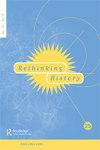两个时间点的全球历史:1990年和2006年在日本长崎的时间、身份和现实历史
IF 0.8
2区 历史学
Q1 HISTORY
引用次数: 0
摘要
摘要本文比较了1990年和2006年在日本长崎举办的两届世博会。这两个博览会都回应了与去工业化相关的结构性经济变化,这促使人们重新认识到这座城市在近代早期作为海上贸易中心的历史。为了比较从这一转折点出现的两种时间性身份,我区分了每一种论述的主要时间点。1990年的旅程博览会以Tabi(旅程)-时间为特色,从遥远的过去出发,穿过正在消失的现在,走向乌托邦式的未来,长崎再次成为国际港口。2006年的Saruku博览会以Saruku(漫步)-时间,它内省地重新发现了长崎在当下的地方遗产,同时想象了一个不变的未来,抹去了形成塔比时代的时间划分。如果说塔比时间是源自国家博览会的国家时间,那么萨鲁库时间则是源自遗产和记忆的地方时间。这些计时码表的特点是博览会场地的不同布置和游客在其游乐场上表演的不同机动性。旅程博览会在空间上将长崎划分为未来和过去的区域,而萨鲁库博览会则以一系列没有明确时间界限的漫步为特色。塔比时代的游客们进行着跨越国界的史诗般的浪漫之旅,而萨鲁库时代的游客则以好奇、慢节奏的方式在当地流离失所。这篇文章引用了指南、官方记录以及当地城镇杂志等博览会文件,认为时间的正式组织实际上可以用于经济和身份建设目的,也可以用于不同政党之间的政治竞争。它还发展了最近的历史理论学术,如海登·怀特的“实践的过去”概念和最近关于后现代时间混乱的理论。本文章由计算机程序翻译,如有差异,请以英文原文为准。
Global history in two chronotopes: time, identity and the practical past in Nagasaki, Japan, 1990 and 2006
ABSTRACT This article compares two recent expositions held in Nagasaki, Japan, in 1990 and 2006. Both expositions responded to structural economic changes related to deindustrialization that prompted reidentifications with the city’s history as a maritime trade hub in early modern Japan. To compare two temporally laced identities that emerged from this turning point, I distinguish each exposition’s dominant chronotope. The 1990 Journey Exposition is characterized by Tabi (Journey)-time, which departs from a distant past to transit through a disappearing present towards a utopian future where Nagasaki has once again become an international port. The 2006 Saruku Expo is characterized by Saruku (Strolling)-time, which introspectively rediscovers Nagasaki’s local heritage within the present while imagining a changeless future, erasing the temporal divisions formative of Tabi-time. If Tabi-time is national time derived from national expositions, Saruku-time is local time derived from heritage and memory. These chronotopes are characterized by different arrangements of exposition grounds and different mobilities that visitors were expected to perform on their fairgrounds. The Journey Exposition spatially delineated Nagasaki into future and past zones, whereas the Saruku Expo featured a series of wandering strolls that drew no clear temporal boundaries. Visitors in Tabi-time engaged in epic, romantic voyages across national borders, whereas visitors in Saruku-time displaced themselves locally in an inquisitive, slow-paced manner. The article draws from exposition documents like guides and official records as well as a local town magazine to argue that the formal organization of time can be practically utilized for economic and identity-building purposes as well as politically contested between different parties. It also develops recent scholarship in Theory of History such as Hayden White’s concept of the ‘practical past’ and recent theorizations on the disorder of postmodern time.
求助全文
通过发布文献求助,成功后即可免费获取论文全文。
去求助
来源期刊

Rethinking History
Multiple-
CiteScore
1.20
自引率
0.00%
发文量
26
期刊介绍:
This acclaimed journal allows historians in a broad range of specialities to experiment with new ways of presenting and interpreting history. Rethinking History challenges the accepted ways of doing history and rethinks the traditional paradigms, providing a unique forum in which practitioners and theorists can debate and expand the boundaries of the discipline.
 求助内容:
求助内容: 应助结果提醒方式:
应助结果提醒方式:


